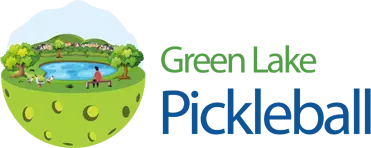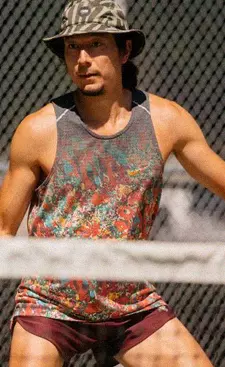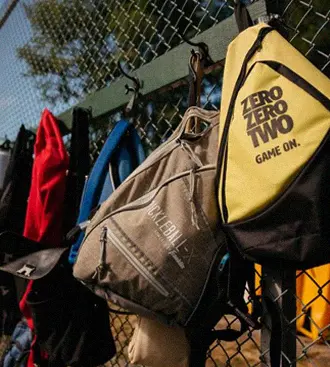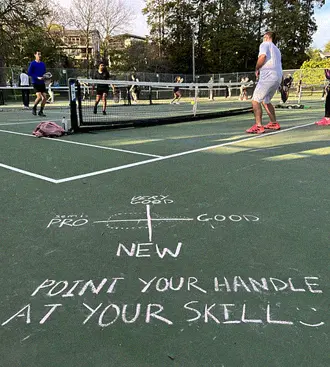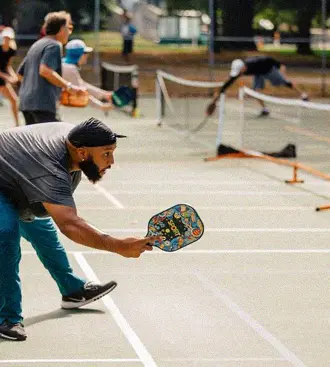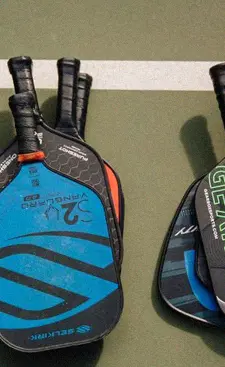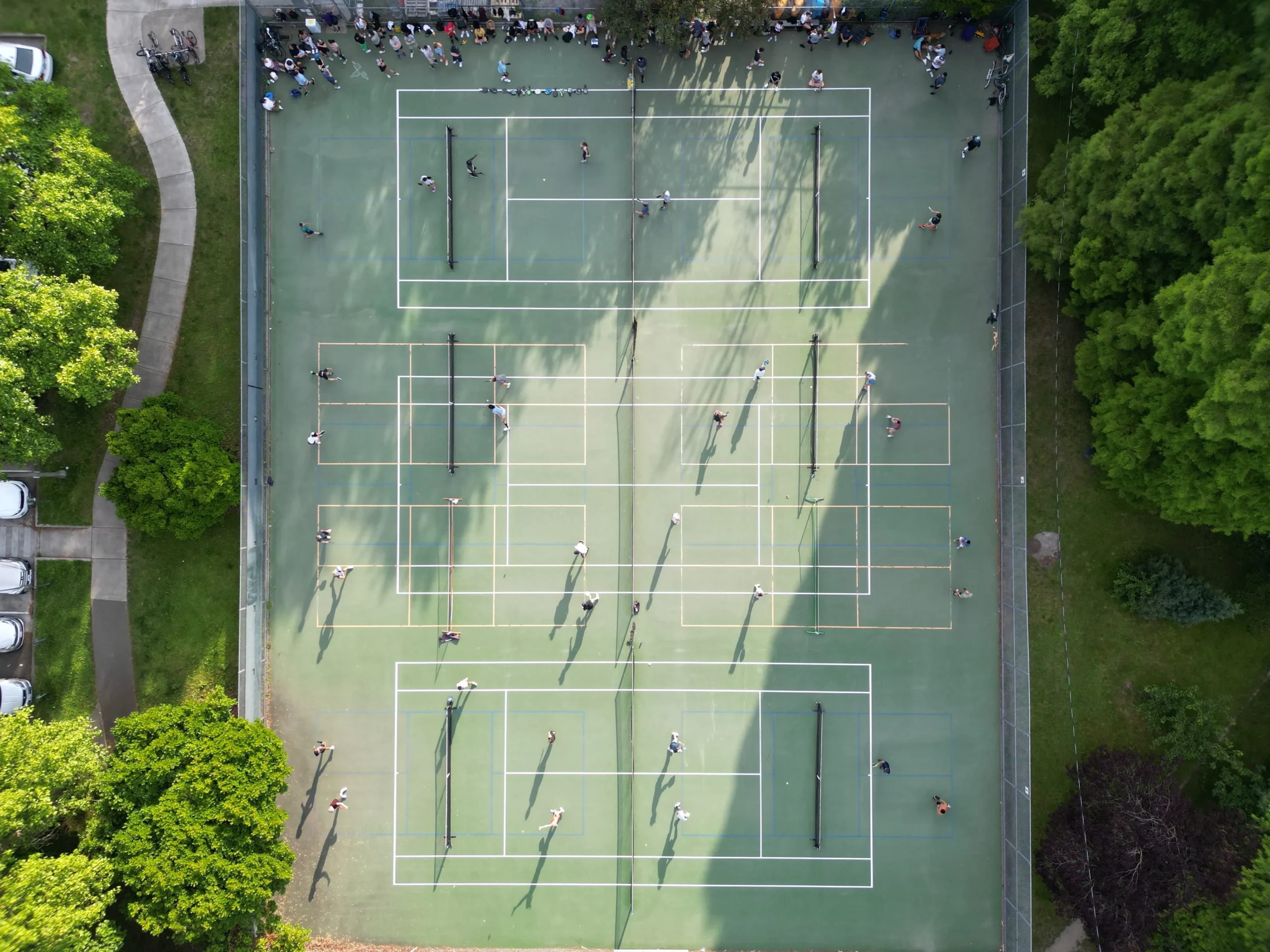General:
It’s the name we’ve chosen for the informal group of pickleball players who gather for “drop-in” play at the Green Lake East outdoor tennis and pickleball courts located near the Green Lake Community Center.
Green Lake East is a public court managed by Seattle Parks and Recreation (SPR). Everyone is welcome to play drop-in doubles or singles pickleball or tennis there at any time the courts are not otherwise reserved by a private party. Except for Spring season after-school use by Blanchet High School’s Junior Varsity Tennis Team, Green Lake East is used mostly for drop-in pickleball.
From mid-March through early October, GLP reserves the courts on weekday evenings (generally 5:30 to dark) and weekend mornings (10 am-noon) exclusively for doubles pickleball play. Everyone (beginner to expert) is welcome. Individuals or parties can reserve the courts at other times for pickleball or tennis through SPR’s rather cumbersome reservation app, but for the most part (95% +) the courts are pretty much only used for drop-in pickleball.
Depending on the time of year and on the weather, GLP spends between $200 and $400 per week on court reservations and another $100, or so, on balls, tape, nets and net repair, court maintenance equipment, etc.. Your contribution of $1 – $3 each time you play defrays those costs. Please add some cash to the kitty-jar next to the supply of balls on the court or Venmo GLP here.
Sign up to receive announcements, via our GLP Google Group, by filling out this form, or check back on this website frequently.
Pickleball Play:
Either! You are welcome to play with one, two, or three other friends … or find new friends by joining a stack with people you might not know (see the “How do I stack …” FAQ, below).
Show up and stack! We use a paddle-stacking system to form a queue for games and to help match players of similar skills. If all else fails, just wander into the fenced area, look a bit lost, and there’s a good chance someone will approach you to explain how to get into a game. If no one does, find a friendly face and ask; we were all beginners at one time, and many of us still remember how intimidating it can be to get started.
Play as many as you want and stay as long as you like, but just one game at a time — and then rotate out to place your paddle at the end of the waiting stacks. We play all games to 11; win by two.
People are playing pretty much any time that it’s not raining. Most popular times are weekend mornings and weekday afternoons; i.e., the exact day/times we reserve courts for exclusive pickleball play (also see the FAQ, “When does GLP reserve the courts …?” above).
GLP Paddle Stacking FAQs:
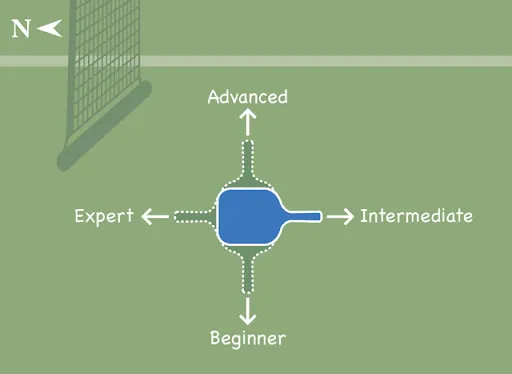 GLP uses a skill-based paddle-stacking system for open play at Green Lake East that was first introduced by a few members of Green Lake Pickleball royalty (Frank Chiappone, Sean Oldridge, Steve Balch, and Clay Hess, to name a few) in the pre-Covid era. That system, with only minor modifications, remains in place today to help match like-skilled players, from beginner to expert, in fun and competitive games.
GLP uses a skill-based paddle-stacking system for open play at Green Lake East that was first introduced by a few members of Green Lake Pickleball royalty (Frank Chiappone, Sean Oldridge, Steve Balch, and Clay Hess, to name a few) in the pre-Covid era. That system, with only minor modifications, remains in place today to help match like-skilled players, from beginner to expert, in fun and competitive games.
Players stack paddles in a queue on the side of the southwesternmost court, with the handle pointing in the direction of their skill, as shown below.
To get in a game, find an incomplete stack (i.e., one with fewer than four paddles) with handles pointed in the direction of your skill level and place your paddle on top. Or start a new stack to the right of the queue with your paddle handle pointed appropriately. Players in the stack farthest to the left take the next available court. When you finish a game, place your paddle back in the queue on a new stack.
GLP SKILL RATINGS (Autumn 2023)
These rating guidelines summarize USAP pickleball rating definitions. Please use them to objectively self-rate your skill level and to identify improvements you need to reach the next skill level. As applicable, stack your paddle diagonally if you self-rate between levels. The more honestly you stack, the better for all players at all levels.
That being said, we collectively grow as a pickleball community by playing with people both stronger and weaker than ourselves. Be both respectful and generous; it’s fun, instructive, and friendly to play “up” and play “down” every now and then.
1. Beginner: 1.0 to 2.5 skill rating
a. Learning the basic shot strokes, scoring, and detailed rules.
b. Can sustain a short rally of easy-paced shots with players of equal ability.
c. Needs to improve consistency, power, net play, and court coverage.
2. Intermediate: 2.5 to 3.5 skill rating
a. Has learned the basic shot strokes, scoring, and detailed rules.
b. Can sustain a rally of medium-paced shots with advanced players.
c. Needs to improve directional intent, power, depth, and consistency, especially in backhand and serve.
d. Needs to improve control of dink rallies, net play, faster-paced court coverage, and strategies.
3. Advanced: 3.5 to 4.5 skill rating
a. Can sustain a rally of fast-paced shots with expert players with consistent and dependable strokes.
b. Demonstrates reliable serves, lobs, overhead slams, dink and drop shots, and uses spin with success.
c. Exhibits more aggressive approach shots and net play.
d. Can occasionally force return failures when serving.
e. Needs to master consistency, power, accuracy, speed, and winning strategies.
f. Needs to better anticipate opponent’s shots for improved court positioning.
4. Expert: 4.5 through 5.5+ skill rating
a. Has mastered the use of varying power, depth, spin, dink and drop shots.
b. Has mastered shot anticipation and shot placement, and regularly hits winning shots.
c. Has mastered a variety of 3rd shot strategies and styles of play with both forehand and backhand.
d. Forces opponents into making errors by aggressively keeping the ball in play.
e. Exhibits patience during rallies with the ability to create an opportunity to attack utilizing the dink.
f. Rarely makes unforced errors.
g. Ready to play and win in competitive or tournament matches.
You don’t have to …. but you won’t make many friends at the courts if you don’t. Here are some thoughts and guidelines that might help you get the most out of your play at GLP and will surely help those you play with get the same.
1. No one can force you to play at any given skill level, but keep in mind that GLP’s stacking system was put in place to help players of all skills levels get the most out of the time they spend on the court during “open-play” times. Some players just want competitive games, some only to learn, some to socialize, but most play at GLP for a combination of all three. Please show respect for all players by stacking appropriately.
a. If you’re stacking “up” a skill level, you might check to see that the more advanced players in your stack are ok with that. A simple, “Do you mind if I try playing a game in your group?” can go a long way toward setting expectations and keeping everyone happy. Remember that one or two non-advanced players in an advanced stack makes the resulting game non-competitive.
b. If you find that you’re generally among much stronger players in whatever skill level you’ve chosen, you’re probably stacking “up.” Try stacking down a level until you’re at the top your group; then it’s time to move up!
c. If you’re an advanced player, consider stacking “down” every now and then or asking an aspiring player to join your group for a game. You might just enjoy the satisfaction that comes with both helping others improve and with making a positive contribution to the GLP community.
2. If you’re unsure of your skill level, self-assess using the “What’s my skill level?” FAQ, above, or ask more advanced players. But don’t take offense if that player assesses you (hopefully in an artful and thoughtful way) below the level in which you typically stack. You can still work towards your desired level and take solace in the fact that you surely have better skills in some areas of life than they do!
3. Unless you’re asked by a player to evaluate their skill level, please refrain from doing so — and particularly refrain from doing so in an unkind or public manner.
“Phantom stacking” is a technique whereby a player, already stacked in the queue — or in a game — has placed a second (“phantom”) paddle in the long queue of stacks to either double their game frequency or to save their place in a stack with other friends. Neither reason justifies the technique, which gives the phantom stacker an unfair playtime advantage. Remember: one player, one paddle. If you want to play in a stack with one, two, or three other friends, have those friends hold their paddles out until you’ve completed your game.
During the day/times that GLP reserves the courts for open play, phantom stackers will be appropriately shunned. At other day/times, see “Lord of the Flies.”
General:
It’s the name we’ve chosen for the informal group of pickleball players who gather for “drop-in” play at the Green Lake East outdoor tennis and pickleball courts located near the Green Lake Community Center.
Green Lake East is a public court managed by Seattle Parks and Recreation (SPR). Everyone is welcome to play drop-in doubles or singles pickleball or tennis there at any time the courts are not otherwise reserved by a private party. Except for Spring season after-school use by Blanchet High School’s Junior Varsity Tennis Team, Green Lake East is used mostly for drop-in pickleball.
From mid-March through early October, GLP reserves the courts on weekday evenings (generally 5:30 to dark) and weekend mornings (10am - noon) exclusively for doubles pickleball play. Everyone (beginner to expert) is welcome. Individuals or parties can reserve the courts at other times for pickleball or tennis through SPR’s rather cumbersome reservation app, but for the most part (95% +) the courts are pretty much only used for drop-in pickleball.
Depending on the time of year and on the weather, GLP spends between $200 and $400 per week on court reservations and another $100, or so, on balls, tape, nets and net repair, court maintenance equipment, etc.. Your contribution of $1 - $3 each time you play defrays those costs. Please add some cash to the kitty-jar next to the supply of balls on the court or Venmo GLP here.
Sign up to receive announcements, via our GLP Google Group, by filling out this form, or check back on this website frequently.
Pickleball Play:
Either! You are welcome to play with one, two, or three other friends … or find new friends by joining a stack with people you might not know (see the “How do I stack …” FAQ, below).
Show up and stack! We use a paddle-stacking system to form a queue for games and to help match players of similar skills. If all else fails, just wander into the fenced area, look a bit lost, and there's a good chance someone will approach you to explain how to get into a game. If no one does, find a friendly face and ask; we were all beginners at one time, and many of us still remember how intimidating it can be to get started.
Play as many as you want and stay as long as you like, but just one game at a time — and then rotate out to place your paddle at the end of the waiting stacks. We play all games to 11; win by two.
People are playing pretty much any time that it’s not raining. Most popular times are weekend mornings and weekday afternoons; i.e., the exact day/times we reserve courts for exclusive pickleball play (also see the FAQ, “When does GLP reserve the courts …?” above).
GLP paddle stacking FAQs:
We use a paddle-stacking method at Green Lake East that was first introduced by a few members of Green Lake Pickleball royalty (Sean Oldridge, Frank Chiaponne, Steve Balch, Miguel deCampos, and Clay Dalton, to name a few) in the pre-Covid era. Pointing your paddle handle to the west (down, toward the lake) says you're just learning the game; handle to the south (right) = intermediate, east (up) = advanced, and north (left) = “expert.” See the diagram below. (Also see the FAQ, “What’s my skill level?”)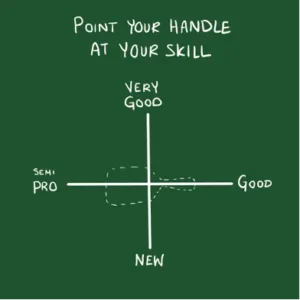
Though there is no absolute way to assess skill level, you might find the following guidelines helpful.
Beginner (rating: 1.0 - 2.0)
- Just starting to play the sport and have limited (or no) racquet-sports background.
- Learning basic pickleball rules and how to keep score properly.
Intermediate (2.0 - 3.0)
- Might have some casual racquet-sport experience.
- Can consistently get serves in the opposite diagonal court.
- Can hit forehand shots in a three or four shot rally.
- Learning to dink.
- Can keep score properly, most of the time.
Advanced I (3.0 – 4.0)
- Might have competitive racquet-sport experience.
- Can hit low forehand drives, serves, and returns of serve with medium speed (pace). Working on your backhand.
- Can dink, but may lack consistency.
- Understand basic pickleball tactics (control the net, use 3rd-shot drops, hit deep returns, etc.), but cannot yet consistently execute them.
- Can keep score properly.
Advanced II (4.0 - 4.5)
- Can hit drives, serves, and returns of serve with good pace (forehand, for sure, and you have a respectable backhand).
- Are comfortable and consistent with dinks and drop shots.
- Have good control.
- Understand, and can consistently execute, basic pickleball tactics.
- Vary your shots between a hard and soft game.
- Move quickly to the kitchen line when you have the opportunity.
Expert (4.5 and up)
- You know who you are.
GLP uses a skill-based paddle-stacking system when the courts are reserved for open play (and most other times, as conditions allow) to help match like-skilled players in games. Here are some guidelines to help you find your right level of play:
- GLP’s stacking system was put in place to help players of all skill levels get the most out of the time they spend on the court. Some players just want competitive games, some only want to learn, some to socialize. But most play at GLE for a combination of all three. Please show respect for all players by stacking appropriately.
- If you’re stacking your paddle “up” a skill level, you might check to see that the more advanced players in your stack are open to recreational play. (Remember that one or two non-advanced players in an advanced stack makes the resulting game non-competitive.)
- If you find that you’re generally among stronger players in whatever skill level you’ve chosen, you’re probably stacking “up.” Try stacking down a level for most games until you’re at the top your group; then it’s time to move up!
- If you’re an advanced player, stack “down” every now and then. You might enjoy the satisfaction that comes with both helping others improve their game and making a positive contribution to the GLP community.
- If you’re unsure of your skill level, self-assess using the checklist above or ask more advanced players. When you get some consensus, you’ve got it nailed!
- Unless you’re asked by a player to evaluate their skill level, please refrain from doing so. Leave that job to one of GLP’s AHBs (“Court Ambassadors,” if you will).
- Don’t take offense if a more advanced player, assesses you below the level in which you typically stack (hopefully delivered in an artful & thoughtful way). You can still work towards your desired level and take solace in the fact that you surely have better skills in some areas of life than they do.
“Phantom stacking” is a stacking technique whereby a player, already stacked in the queue --- or already in a game --- has placed a second (“phantom”) paddle in the long queue of stacks to either double their game frequency or to cut ahead to save their place in a stack with other friends. Neither reason justifies the technique, which gives the phantom stacker an unfair playtime advantage. Remember: one player, one paddle. If you want to play in a stack with one, two, or three other friends, have those friends hold their paddles out until you’ve completed your game.
During the day/times that GLP reserves the courts for open play, phantom stackers will be appropriately shunned. At other day/times, see “Lord of the Flies.”
GLP uses a skill-based paddle-stacking system for open play at Green Lake East that was first introduced by a few members of Green Lake Pickleball royalty (Sean Oldridge, Frank Chiaponne, Steve Balch, Miguel de Campos, and Clay Dalton, to name a few) in the pre-Covid era. That system, with only minor modifications, remains in place today to help match like-skilled players, from beginner to expert, in fun and competitive games.
Players stack paddles in a queue on the side of the southwesternmost court, with the handle pointing in the direction of their skill, as shown below.
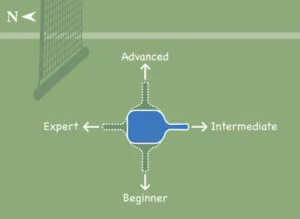
To get in a game, find an incomplete stack (i.e., one with fewer than four paddles) with handles pointed in the direction of your skill level and place your paddle on top. Or start a new stack to the right of the queue with your paddle handle pointed appropriately. Players in the stack farthest to the left take the next available court. When you finish a game, place your paddle back in the queue in a new stack.
Though there is no absolute way to assess skill level, you might find the following guidelines helpful.
- Beginner (rating: 1.0 - 2.5)
- Learning the basic shot strokes, scoring, and detailed rules.
- Can sustain a short rally of easy-paced shots with players of equal ability.
- Needs to improve consistency, power, net play, and court coverage.
- Intermediate (2.5 - 3.5)
- Has learned the basic shot strokes, scoring, and detailed rules.
- Can sustain a rally of medium-paced shots with advanced players.
- Needs to improve directional intent, power, depth, and consistency, especially in the backhand and serve.
- Needs to improve control of dink rallies, net play, faster-paced court coverage, and strategies.
- Advanced (3.5 – 4.5)
- Can sustain a rally of fast-paced shots with expert players with consistent and dependable strokes.
- Demonstrates reliable serves, lobs, overhead slams, dink, and drop shots, and uses spin with success.
- Exhibits more aggressive approach shots and net play.
- Can occasionally force return failures when serving.
- Needs to master consistency, power, accuracy, speed, and winning strategies.
- Needs to better anticipate the opponent’s shots for improved court positioning.
- Expert (4.5 and up)
- You know who you are, but if you really want to know:
- Can sustain a rally of fast-paced shots with expert players with consistent and dependable strokes.
- Demonstrates reliable serves, lobs, overhead slams, dink, and drop shots, and uses spin with success.
- Exhibits more aggressive approach shots and net play.
- Can occasionally force return failures when serving.
- Needs to master consistency, power, accuracy, speed, and winning strategies.
- Needs to better anticipate the opponent’s shots for improved court positioning.
Note: These rating guidelines summarize those published by USA Pickleball. Please use them to objectively self-rate your skill and to identify improvements you need to reach the next level. As applicable, stack your paddle diagonally if you self-rate between levels. The more honestly you stack, the better for all players.
That being said, we collectively grow as a pickleball community by playing with people both stronger and weaker than ourselves. Please be both respectful and generous; it’s fun, instructive, and friendly to play “up” and play “down” every now and then.
You don’t have to …. but you won’t make many friends at the courts if you don’t. Here are some thoughts and guidelines that might help you get the most out of your play at GLE and will surely help those you play with get the same.
- No one can force you to play at any given skill level, but keep in mind that GLP’s stacking system was put in place to help players of all skills levels get the most out of the time they spend on the court during “open-play”times. Some players just want competitive games, some only to learn, some to socialize, but most play at GLE for a combination of all three. Please show respect for all players by stacking appropriately.
- If you’re stacking “up” a skill level, you might check to see that the more advanced players in your stack are ok with that. A simple, “Do you mind if I try playing a game in your group?” can go a long way toward setting expectations and keeping everyone happy. Remember that one or two non-advanced players in an advanced stack makes the resulting game non-competitive.
- If you find that you’re generally among much stronger players in whatever skill level you’ve chosen, you’re probably stacking “up.” Try stacking down a level until you’re at the top your group; then it’s time to move up!
- If you’re an advanced player, consider stacking “down” every now and then or asking an aspiring player to join your group for a game. You might just enjoy the satisfaction that comes with both helping others improve and with making a positive contribution to the GLP community.
- If you’re unsure of your skill level, self-assess using the “What’s my skill level?” FAQ, above, or ask more advanced players. But don’t take offense if that player assesses you (hopefully in an artful and thoughtful way) below the level in which you typically stack. You can still work towards your desired level and take solace in the fact that you surely have better skills in some areas of life than they do!
- Unless you’re asked by a player to evaluate their skill level, please refrain from doing so --- and particularly refrain from doing so in an unkind or public manner.
“Phantom stacking” is a technique whereby a player, already stacked in the queue --- or in a game --- has placed a second (“phantom”) paddle in the long queue of stacks to either double their game frequency or to save their place in a stack with other friends. Neither reason justifies the technique, which gives the phantom stacker an unfair playtime advantage. Remember: one player, one paddle. If you want to play in a stack with one, two, or three other friends, have those friends hold their paddles out until you’ve completed your game.
During the day/times that GLP reserves the courts for open play, phantom stackers will be appropriately shunned. At other day/times, see “Lord of the Flies.”
